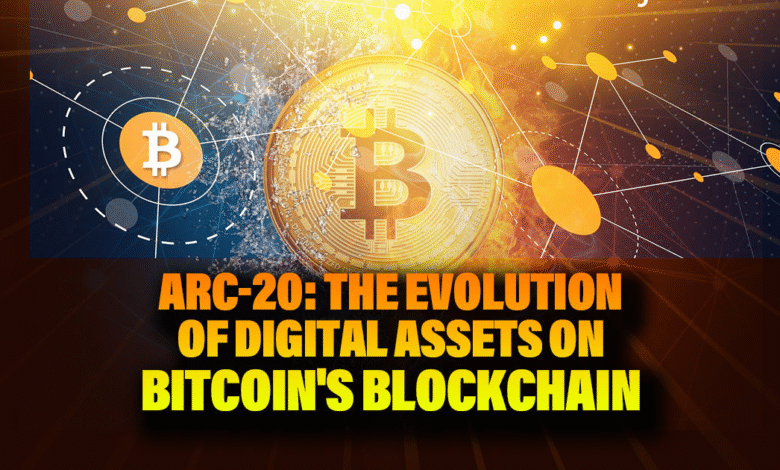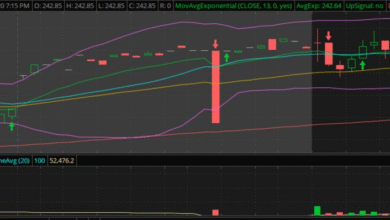Arc Blockchain: Circle Unveils New Technology with USDC

Arc Blockchain is an innovative Layer 1 blockchain unveiled by Circle Internet Group, designed to revolutionize stablecoin finance by employing USDC as its native gas for transaction fees. With a staggering $65.23 billion market cap, USDC remains one of the leading fiat-backed stablecoins, fueling the demand for reliable and efficient cryptocurrency transactions. As Circle expands its ecosystem with Arc, it positions itself among notable competitors like Kraken and Coinbase, who are also launching their own blockchains. This EVM-compatible network isn’t just about reducing gas fees; it aims to set the standard for enterprise-grade applications in payments, foreign exchange, and capital markets. With its debut public testnet expected this fall, Arc Blockchain is geared to redefine the landscape of decentralized finance and stablecoin utility in the ever-evolving crypto market.
Introducing Arc Blockchain, the latest creation from Circle Internet Group, which is set to transform the realm of digital finance. This newly designed Layer 1 infrastructure uses USDC as its primary fuel for transaction fees, highlighting a crucial step in the evolution of stablecoin technology. As companies rush to build their independent blockchain solutions, Arc emerges as a formidable player in the EVM-compatible sector, providing robust support for stablecoin financial applications. By focusing on improving transaction efficiency and supporting enterprise-level applications, Arc aims to make significant waves in the cryptocurrency ecosystem. This strategic move not only allows Circle to innovate further but also strengthens its position in the competitive landscape of blockchain technology.
Circle Internet Group’s Vision for Stablecoin Finance
Circle Internet Group is paving the way for the future of stablecoin finance with its innovative Arc Blockchain. This new Layer 1 solution is specifically designed to facilitate transactions with USDC as its native gas. By integrating USDC into the fabric of its blockchain operations, Circle aims to streamline financial applications, making it easier for businesses and consumers to engage in digital transactions with reduced friction.
As the second-largest fiat-backed stablecoin, USDC boasts a robust market presence and is a critical component of Circle’s strategy. With USDC’s impressive growth trajectory—reporting an increase from $61.3 billion to $65.2 billion in circulation—Circle’s move towards an EVM-compatible blockchain reflects a commitment to enhancing the usability and functionality of stablecoins in everyday finance.
Understanding the Benefits of Arc Blockchain for Users
The Arc Blockchain is designed to deliver significant benefits to its users, particularly in the realm of transaction fees. By utilizing USDC as the native gas for transactions, users can expect faster and more efficient transfers without the volatility typically associated with other cryptocurrencies. This strategic choice positions Circle’s blockchain as a reliable mechanism for everyday transactions, where stability in fees is paramount for user trust and platform adoption.
Furthermore, the Arc Blockchain’s compatibility with Ethereum Virtual Machine (EVM) means that developers can seamlessly port their existing dApps over to Circle’s platform without undergoing significant rewrites. This opens the door for a new wave of innovative applications in stablecoin finance, capitalizing on the reliability of USDC to facilitate transactions and ensure instant settlement finality, thus enhancing overall user experience.
The Launch Timeline of Arc Blockchain
Circle has announced an ambitious timeline for the rollout of the Arc Blockchain, with plans for a public testnet set to launch this fall. This timeline is crucial as it allows developers and potential users to engage with the platform and provide feedback before its full-scale launch. The testnet phase will enable various stakeholders to explore the blockchain’s features, particularly its emphasis on speed and privacy, which are vital for stablecoin finance.
The anticipation surrounding the launch of Arc is building as it promises not only to reinforce Circle’s position in the competitive blockchain ecosystem but also to provide tangible solutions to common problems faced in digital transactions today. As more companies explore the benefits of Layer 1 solutions over Layer 2 builds, Circle’s efforts may shape future developments in the broader blockchain landscape.
EVM Compatibility: A Game-Changer for Blockchain Development
One of the standout features of the Arc Blockchain is its EVM compatibility, which is set to revolutionize how developers create and deploy decentralized applications. This compatibility allows developers accustomed to building on Ethereum to easily transition their dApps to Arc without facing the steep learning curve that often accompanies new blockchain technologies. This is particularly beneficial for the growth of stablecoin finance, as it encourages existing projects to adapt to a more stable environment.
Moreover, EVM compatibility ensures that Arc can integrate seamlessly with numerous other projects and protocols across the Ethereum ecosystem. This interoperability not only enhances the functionality of applications built on Arc but also increases the overall liquidity and usage of USDC as it can be utilized in a wider array of financial applications across multiple platforms.
Circle’s Response to Competitors in the Blockchain Space
In the rapidly evolving blockchain landscape, Circle’s introduction of the Arc Blockchain positions it strategically against major competitors like Kraken, Coinbase, and Binance, who are also establishing their own networks. As many companies choose to build Layer 2 solutions, Circle’s commitment to a Layer 1 blockchain underscores its goal to remain at the forefront of stablecoin finance and the broader DeFi space. This proactive approach sets Circle apart, as it offers a full-stack solution designed for enterprise-grade applications.
By focusing on an L1 solution, Circle emphasizes scalability, speed, and security—qualities that are essential for attracting both individual users and institutional investors. This decision not only enhances Circle’s market competitiveness but also reinforces the notion that the future of blockchain finance lies in foundational technologies that can sustain widespread adoption and innovation.
USDC Gas Fees: Making Transactions Affordable and Efficient
A key advantage of the Arc Blockchain is its implementation of USDC as the native gas for transactions, ensuring that gas fees remain stable and predictable. This innovation addresses one of the main concerns surrounding blockchain transactions—the volatility of gas fees that can fluctuate dramatically. By standardizing transaction costs with USDC, Circle creates a more user-friendly environment for both consumers and businesses engaged in digital finance.
As transaction volume increases, the affordability of USDC gas fees becomes critical. This could potentially lead to a higher frequency of transactions, thereby fostering a vibrant ecosystem around stablecoin finance. By offering stability in fees, Circle not only enhances user satisfaction but also encourages more individuals and businesses to integrate blockchain technology into their payment systems.
Innovations in Stablecoin Payments with Arc Blockchain
The introduction of the Arc Blockchain opens new avenues for innovations in stablecoin payments, particularly with its built-in features aimed at improving payment efficiency. By incorporating an integrated stablecoin FX engine and sub-second settlement finality, Circle is revolutionizing the way stablecoins are utilized in capital markets and payment processes. These advancements position USDC as a formidable player in the global financial system.
Moreover, Circle’s commitment to opt-in privacy controls offers users an additional layer of security and peace of mind. This is particularly important in the age of digital transactions, where privacy concerns are paramount. By enabling users to choose how much information they share, Arc fosters trust among its users, which is essential for the widespread adoption of cryptocurrency solutions.
The Future of Circle’s Arc Blockchain and Evolving DeFi Landscape
As Circle prepares for the launch of Arc, the future looks bright for both the company and the evolving landscape of decentralized finance (DeFi). The incorporation of USDC into a robust Layer 1 blockchain framework represents a significant step towards making stablecoins mainstream. As more users and developers begin to recognize the benefits of a stable, efficient, and user-friendly platform, Circle’s Arc could very well reshape how stablecoin transactions are conducted in the financial sector.
Looking forward, the success of the Arc Blockchain will depend on its ability to attract a vibrant community of developers and users. By providing the necessary tools and infrastructure to support dApp development, Circle can ensure that its blockchain remains competitive. If successful, this could lead to a surge in innovative financial products and services that leverage stablecoin technology, further entrenching USDC’s position as a leading global stablecoin.
Frequently Asked Questions
What is Arc Blockchain and how does it utilize USDC?
Arc Blockchain is a Layer 1 blockchain developed by Circle Internet Group specifically designed for stablecoin finance. It leverages USDC as its native gas, meaning that all transaction fees on the network are paid using USDC, enhancing efficiency and usability for stablecoin transactions.
How does Arc Blockchain compare to other EVM-compatible blockchains?
Arc Blockchain is an EVM-compatible Layer 1 blockchain which allows developers to build decentralized applications using Ethereum’s programming language. Unlike some competitors, Arc focuses on optimizing stablecoin finance with integrated features like USDC gas fees, making it a unique choice for projects that prioritize stablecoin interactions.
What advantages does Arc Blockchain offer for stablecoin payments?
Arc Blockchain offers several advantages for stablecoin payments including sub-second settlement finality for transactions, an integrated foreign exchange engine for stablecoins, and privacy controls. By using USDC as its native gas, it streamlines transaction processes in the stablecoin finance ecosystem.
When will Arc Blockchain’s public testnet be available?
The public testnet for Arc Blockchain is expected to debut this fall. This testnet will allow developers and users to explore the features of the EVM-compatible architecture and utilize USDC for transaction fees in a controlled environment.
How will Arc Blockchain enhance Circle’s platform and services?
Arc Blockchain is designed to deeply integrate with Circle’s existing platform and services, providing an enterprise-grade solution for stablecoin finance. Its capabilities, including swift transaction processing and compatibility with other blockchains, will enhance the overall financial system Circle aims to build.
What makes Arc Blockchain stand out among Layer 1 blockchains?
Arc Blockchain stands out as it combines an EVM-compatible structure with a focus on stablecoin finance, utilizing USDC as gas fees. This integration and its targeted features for businesses engaging with currencies make it a crucial player in the evolving landscape of Layer 1 blockchains.
Who are the competitors of Arc Blockchain in the Layer 1 blockchain space?
Arc Blockchain competes with several Layer 1 blockchain projects such as Kraken’s Ink, Coinbase’s Base, and Binance’s BNB Chain, which have also focused on building out their respective ecosystems. The emergence of these platforms highlights the growing trend of proprietary blockchains in stablecoin finance.
What is the future vision for Arc Blockchain according to Circle?
Circle envisions Arc Blockchain as a pivotal component of a full-stack internet financial system, aiming to deliver seamless and robust stablecoin finance solutions. This vision emphasizes the importance of interoperability, speed, and user privacy within the blockchain landscape.
| Key Points |
|---|
| Circle has announced a new layer one blockchain called Arc, which will utilize USDC as its native gas for transaction fees. |
| USDC is the second-largest fiat-backed cryptocurrency, with a market capitalization of $65.23 billion. |
| Circle’s Q2 report indicated that USDC circulation grew by 90% year-over-year, reaching $61.3 billion. |
| Arc aims to provide a robust infrastructure for stablecoin finance, encompassing payments, foreign exchange (FX), and capital markets. |
| The blockchain will be EVM-compatible, featuring a stablecoin FX engine and privacy controls. |
| Circle plans to launch a public testnet for Arc in the fall. |
Summary
Arc Blockchain marks a significant step for Circle as it enters the competitive arena of blockchain technology. By leveraging USDC as its native gas, Arc aims to enhance the functionality and efficiency of stablecoin transactions, setting a new standard in the market. The introduction of this layer-one blockchain not only reflects Circle’s commitment to innovation but also positions itself alongside other major players in the blockchain sector. With features designed for enterprise-grade financial applications, Arc Blockchain is poised to play a pivotal role in the future of digital finance.




